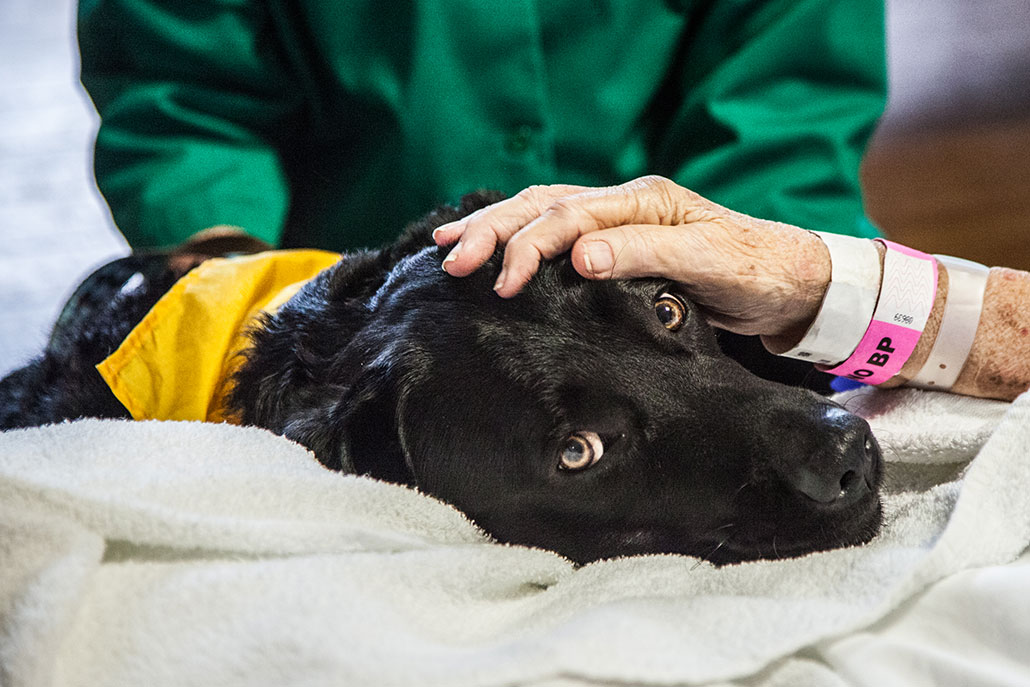In an emergency, you may want to see Dr. Dog
A therapy pooch can reduce pain and anxiety in emergency room patients, a new study finds

Here, a therapy dog visits a hospital patient. A new study finds these visits may bring more than just smiles. They may also reduce some symptoms in emergency room patients.
monkeybusinessimages/iStock/Getty Images Plus
For many emergency room patients, a little canine therapy can help. A new study found that a short visit with a dog reduced pain and anxiety in a large share of these patients.
You expect to see doctors and nurses at hospitals. But some volunteers bring dogs to visit patients, too. These pets may even visit with hospital workers. The idea is that interacting with pets can help people relax — and maybe even boost someone’s recovery. But there hasn’t been much research to prove it.
So researchers in Canada at the University of Saskatchewan tested that. They had therapy dogs visit 97 patients in the emergency department of a local hospital. It was on the school’s campus in Saskatoon. After one 10-minute visit, 43 percent of the patients said they felt less pain. Almost half of patients said they were less anxious after the dog’s visit. Forty-six percent of patients reported being less depressed. Another 101 patients who did not visit with the dogs reported no change in these symptoms.
The share of patients who felt less pain after the visits was impressive. Although the amount of pain relief was small, any drop can be important. Pain is a main reason some four in every five patients visit a hospital’s emergency room, note Colleen Anne Dell and her team.
Dell is a sociologist who co-led the new study. She’s happy about its findings. But really, she says, “it’s about the animals.” Dell has worked with Indigenous peoples in Canada. She says animal therapy fits with their approach to health. “It’s about balance in our relationships with the environment,” she explains. This study shows how animals can be part of a care team.
Dell’s group shared its findings March 9 in PLOS ONE.

Educators and Parents, Sign Up for The Cheat Sheet
Weekly updates to help you use Science News Explores in the learning environment
Thank you for signing up!
There was a problem signing you up.
Strengths and weaknesses
More than 20 years ago, Sandra Barker started one of the first therapy-dog programs in hospitals. At the time, she worked at Virginia Commonwealth University, or VCU, in Richmond, Va. By now, this licensed clinical therapist has lots of experience with patient-pet interactions. Barker likes that the new study included lots of patients. Many studies on pet therapy, she notes, have included only a small number of patients. That can be a problem, since large studies tend to be stronger and their findings more reliable.
However, she points out, there is no way to be sure the effects reported here were due to the dog and not its handler. Having a visitor — dog or human — could have distracted patients so that they no longer focused as much on their symptoms. The study also did not account for treatments the patients may have gotten. Fewer than 25 percent of the patients got pain medicine during the study. Only one may have felt less pain because of medication during that time. Studies like this are “extremely challenging,” Barker explains.

Still, Barker says this is a good addition to the research on therapy animals.
But dog therapy has its risks. Some people are allergic to pet hair and dander. Others may be afraid of dogs. The animals might even bring an infection or fleas to the hospital. Or the dogs might pick up an infection from a patient.
Barker and her VCU colleague Nancy Gee reviewed research, last year, showing how to lessen all these risks. They advise grooming dogs at least 24 hours before a therapy visit. The animals also should be checked to make sure they show no signs of illness. These dogs must be well-trained and have the right personality for the work. Finally, volunteers should get training if they want to use their pets as therapy animals.
Elisabeth Van Every agrees. She works for Pet Partners. The group, based in Bellevue, Wash., registers animals and their handlers to volunteer as therapy teams. Registered teams must follow safety guidelines before taking an animal to visit a patient, Van Every says. The teams also must make sure hospitals know when they are coming. This way, people with pet allergies can avoid the visiting dogs. And in every case, she points out, patients must be given the chance to say “no thank you” if they don’t want to visit with a therapy animal.
But as the new study shows, in the right environment and for the right people, dogs just might be tail-wagging medicine.







